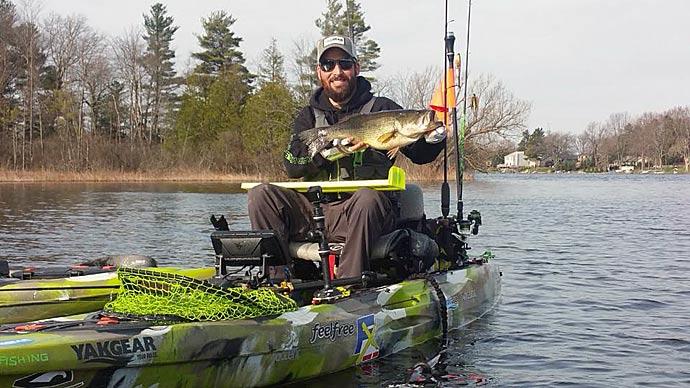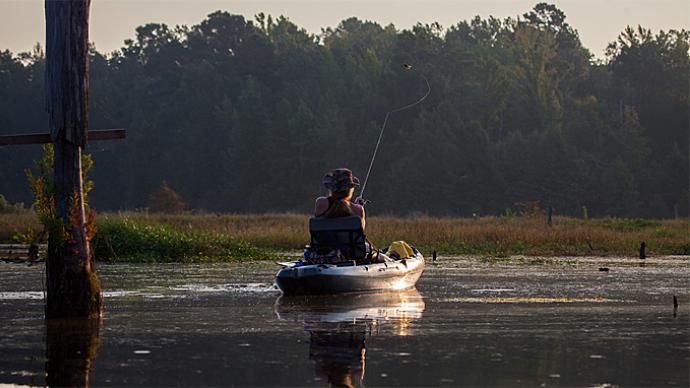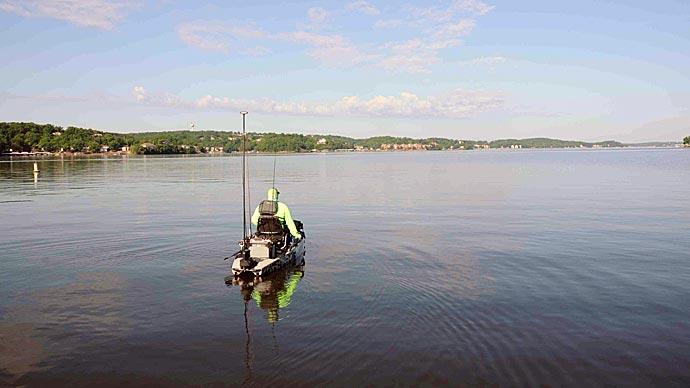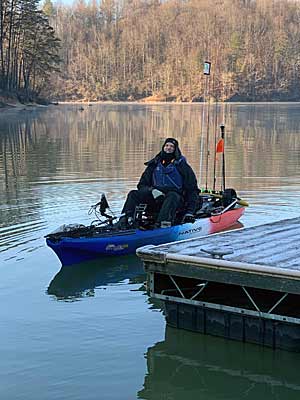
Everyone struggled in 2020, the year of the COVID pandemic. But Tim Fitz found a few reasons to smile, including some recently purchased property on the shores of Kerr Scott Lake in North Carolina’s mountains and a bass boat to enjoy it. A puppy joined his family, too.
While helping the dog adjust to his South Charlotte home’s invisible fence, the trainer noticed Fitz’s boat, calling it a “glitter rocket.” After a request for clarification, the discussion turned to Queen City Kayak Bass Fishing, a group of more than 100 diehard anglers who act like a big family and prefer to paddle or pedal on the Carolinas’ best bass-fishing spots. The trainer is a member, and the more they talked, the more Fitz was sold on the club. It sounded like the perfect place to hone his fishing skills and knowledge.
Fitz isn’t a complete bass-fishing rookie. “I’ve been fishing since I was five,” he said. But it was restricted to summertime trips to his father’s lakeside Missouri home or vacations to Canada. So, he joined Queen City’s Facebook page and met its founder and tournament director, Vinny Ferreri. After some encouragement, he took the plunge, buying a kayak and fishing his first tournament. “It’s fun just to go fishing,” he said. “And if I win money, all the better.”
Because of relatively low costs, accessibility to more waters, or the challenge, kayak fishing participation has exploded over the past decade. Kayak bass tournaments are following a parallel path. Ferreri said Queen City averaged 27 anglers during its first season of monthly tournaments. That grew to 93 in 2020, its sixth year. “We’ve become the largest grass-roots [kayak] club in the country,” he said. “When we started, we weren’t the biggest in the state.”
While Queen City has a core group of anglers who’ve been there since Day 1, Ferreri said there are always a dozen new anglers ready to start each season, with more joining as it progresses. Some are entirely new to kayaks and tournaments. Some are former bass boaters with tournament experience looking for fewer expenses and more camaraderie. But most are like Fitz: They want to become better anglers by testing their skills against and learning from more experienced anglers. If you count yourself in one of these groups, you’re about to embark on an exciting and fruitful fishing adventure. But before you shove off, Fritz and Ferreri have some advice to help you prepare, ensuring you get the most from it.
Keep perspective
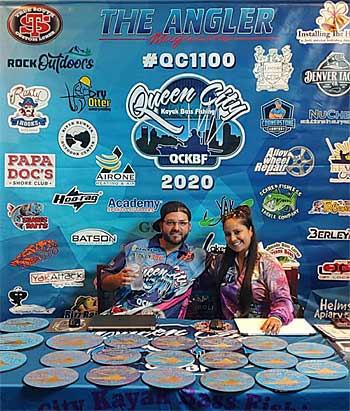
When Queen City held tournament-morning meetings, Ferreri could spot a rookie from across the parking lot. Wide awake since probably 3 a.m. and twitchy from too many cups of coffee, they felt ready to go, having repeatedly reviewed their gear. “And they usually still forgot something,” he said. What they need to remember, he said, is to relax and enjoy themselves.
Each competitor has eight hours to catch a four-bass limit, so Ferreri said you’re fishing against the fish, not other competitors. “The guys who are winning aren’t catching 30 fish,” he said. “They’re catching the fish they need to win.” And many times, that’s only five or six bites. “Anyone who fishes thinks they can do that,” he said. “It’s just going fishing. I tell new guys it’s just four fish. They start to realize that it’s just fun.”
When Ferreri launched Queen City, most other kayak tournaments counted each angler’s best three or five bass. “We went in the middle,” he said. While winning three-bass limits must have giants, and a five-fish limit opens the door to being beat by numbers of smaller bass, he feels a four-bass limit is in the sweet spot, blending quality and quantity. Queen City winners usually post an 18-inch average — 72 inches total. “It’s doable — have a decent day, and you win,” he said.
The opportunity to do well is one reason Queen City has proven popular. Its varied tournament offerings are another. Each year brings nine trail tournaments, where a $58 entry fee — you’ll need to pay a $40 yearly membership, too, to earn angler of the year points — gives you a crack at a $1,200 top prize. Sponsor support guarantees that along with a payout that goes to 10% plus two of the field. There also is a charity tournament — the most recently raised $3,200 for Charlotte-based Emerald School of Excellence, which helps teens with substance abuse disorders — and a team division. And for members with time on their hands or those who can’t fish weekends, there are month-long online events: Fish whenever and wherever you want in the Carolinas, and the four biggest bass you submit are scored.
Know the rules
Kayak bass tournament rules, in general, mirror those used in tournaments involving bass boats. But there are differences, so Ferreri said it's vital for first-timers to read and understand the ones written for the tournament that they are fishing. Do that before your first cast and have the tournament director answer all your questions.
The most significant difference is what types of watercraft are allowed. While most of the competitors in Ferreri’s tournaments use kayaks, stand-up paddleboards and canoes could be used, too. No motors or engines are permitted. Pedal-drive kayaks are OK, he said, and offer an advantage. “How big is up the angler,” he said. The distance between fishing holes, the time it takes to reach them, and your limitations must be considered and balanced during your preparation.
One other difference is trolling. It’s permitted in most kayak tournaments, including Queen City. It takes time to get between spots, so why not have a lure in the water while you’re paddling? Ferreri never heard it questioned until pedal-driven kayaks arrived, and some anglers began dedicating their day to the technique. That ruffled some feathers, so he changed his rules. Now only one rod, not two, can be used simultaneously. “I think it’s part of the game,” he said.
At the beginning of the 2020 season, Ferreri required his competitors to download and use the TourneyX Pro app, a move many other kayak tournament trails have made. For example, it handles entry fee payments and lets anglers check-in tournament morning. Most kayak tournaments allow anglers to use multiple launch sites, dispersing the field and making it feasible to fish large bodies of water. Ferreri tells his anglers to check in before they unload, letting officials know where they’re starting and ready to go. You're disqualified if you forget in his tournaments and his officials can’t reach you before the start. “You’d be surprised how many guys forget to hit the check-in button,” he said.
You’ll be required to bring items beyond your fishing gear, such as state-mandated safety equipment — a personal flotation device, sound-emitting device, and white-light-emitting device in the Carolinas, for example — a ruler, and identification card and holder. And you’ll want some food and water.
Measure correctly
Kayaks lack livewells, so bass is scored by length as they’re caught. Ferreri said Queen City requires using one of two metal rulers made by Ketch Products. Each competitor then submits a photo of each catch on their board through the app. But not any photo will do.

Ferreri said photo standards are relatively uniform among kayak tournament organizations. They include facing bass to the left, making sure its mouth is closed, keeping fingers from under its gill plate, and leaving its eye uncovered. The last one helps determine if the bass is alive. Dead bass have yellowish eyes that look flat and seem to gaze off into space, he said.
Your ID needs to be in the photo, too. Found tournament morning on the app and written on a club-generated card printed ahead of time, it, along with the location settings that your smartphone attaches to each photo, identifies the catch as yours, unique, and happening within tournament hours. While some tournaments require a specific ID placement, Ferreri said Queen City judges only need to be able to read it.
Tournament judges — Ferreri’s wife, Mary, and his best friend fill the roles with Queen City — review every submission, determining an official length and disqualifying substandard photos. Fitz felt the latter firsthand. One of his first two bass in a recent monthly tournament was disqualified. He said his glare kept judges from reading his ID.
Practice is the key to eliminating photo errors. Ferreri said TourneyX has a demo event just for that. Preparation helps, too. Your ID card, net, ruler, and clip — used to secure bass during measuring and photographing — and smartphone should be at the ready before you start fishing. “When you land one, take your time,” he said. “Get your first picture, and check it on the phone. Then go for the best picture.”
Your catch isn’t automatically lost if the photo is DQ’d. Ferreri said his judges would reach out, asking if a second one is available. And it’s not only rookies who receive that request. “[Mistakes] happen to veterans, too,” he said. “You catch a giant fish and forget to put a small business card size identifier in the picture.”
Be social
The COVID pandemic damaged Queen City’s post-tournament ceremonies in 2020. “It has been a little rough,” Ferreri said. He followed recommendations from both Carolinas and pushed them online. They’ll return to in-person when COVID restrictions are lifted.
Ferreri said competitors must attend the gatherings to earn points for their angler of the year. They also help generate traffic at sponsor businesses, a way to thank them for supplementing payouts. And they provide the chance to put faces with names, present the winner with a plaque and top finishers with certificates, and give everyone a chance at raffles.
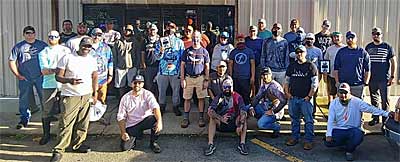
But the real prize, especially for rookies, is hearing the top finishers explain how they caught their bass. While it’s rare that you’ll get an exact location, learning about how they adapted to the conditions will pay off in the long run. You can stash away that information, building your skill set. Keep repeating the process at different waters and times, and it won’t be long until you’re explaining how you won to the rest of the field.
Learning happens elsewhere, including lively discussions on the club’s Facebook page. It’s there that members will post open invitations to join upcoming fishing trips or partner up for the club’s team events. “That’s the big thing,” he said. “Everybody is willing to help the new guy.”
Fitz felt that help when he fished his first Queen City trail tournament, held on a windy but bluebird January day on North Carolina’s Lake James, which is about halfway between Asheville and Hickory. For example, offers to help load his kayak came from members he had yet to meet. Though he was prepared with a glare-resistant ID holder — a lesson learned from the earlier event — the bass didn’t cooperate. But knowing he wasn’t the only one who struggled — more than half of the 110 anglers didn’t record a bass — brought perspective. “For me, it was about the experience,” he said.
It wasn’t long after leaving James that Fitz was ready to add more fishing experience at the next Queen City trail event, slated for Lake Norman, a few miles north on Interstate 77 from his home. That’ll include refining his knowledge and use of finesse and other cold-water techniques and improving control of his kayak, which provides stealthier and easier access to more water than his bass boat but makes casting and presentations a bit trickier. “I’m excited [for Lake Norman],” he said. “I can only go up from here. In the worst case, I meet some more people.”


